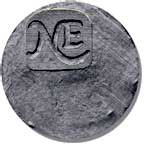
Uncovering America's Heritage... Coin by Coin
New England Coinage
The coin I've chosen for December is pretty special, though it may not look like it at first glance. It's rather simple, really. But here's what's so special about it: history names the New England shilling as the very first coin struck for everyday use in the British colonies of America!
The year was 1652 when the colony at Massachusetts Bay began making these coins. That's only about 22 years after the Pilgrims landed and founded Plymouth. But during that 22 years, money was usually hard to get. The British, rather than pay for goods from the colonies with money, liked to trade other goods instead. This is called "bartering."
Bartering works pretty well, but using money works much better. So the Massachusetts Bay Colony set up a mint in Boston to make coins. To be counted as worth a shilling, each coin had to be made of a certain amount of silver. The mint's first coin was this simple New England shilling (equal to 12 pence). Smaller coins soon followed, marked for smaller amounts.
But the simple design was easy to copy. People could make similar coins using less expensive metals, which is called "counterfeiting." They could also shave silver off the real coin's edges, later selling the silver shavings and leaving the real coins smaller and worth less.
The Massachusetts mint soon stopped making these coins. Its new coins made counterfeiting harder because they had more details on them, including a tree on one side. The designs used a willow tree, then an oak tree, and then a pine tree (like the one in November 2001's Coin of the Month).
These "tree" shillings were made for about 30 years, but they were almost all dated 1652. Why? Travel with Flip to find out in the Time Machine, colonial era!
From this simple start, these "New England" coins began to meet an important need in the colonies: the need for coinage.
—Peter




